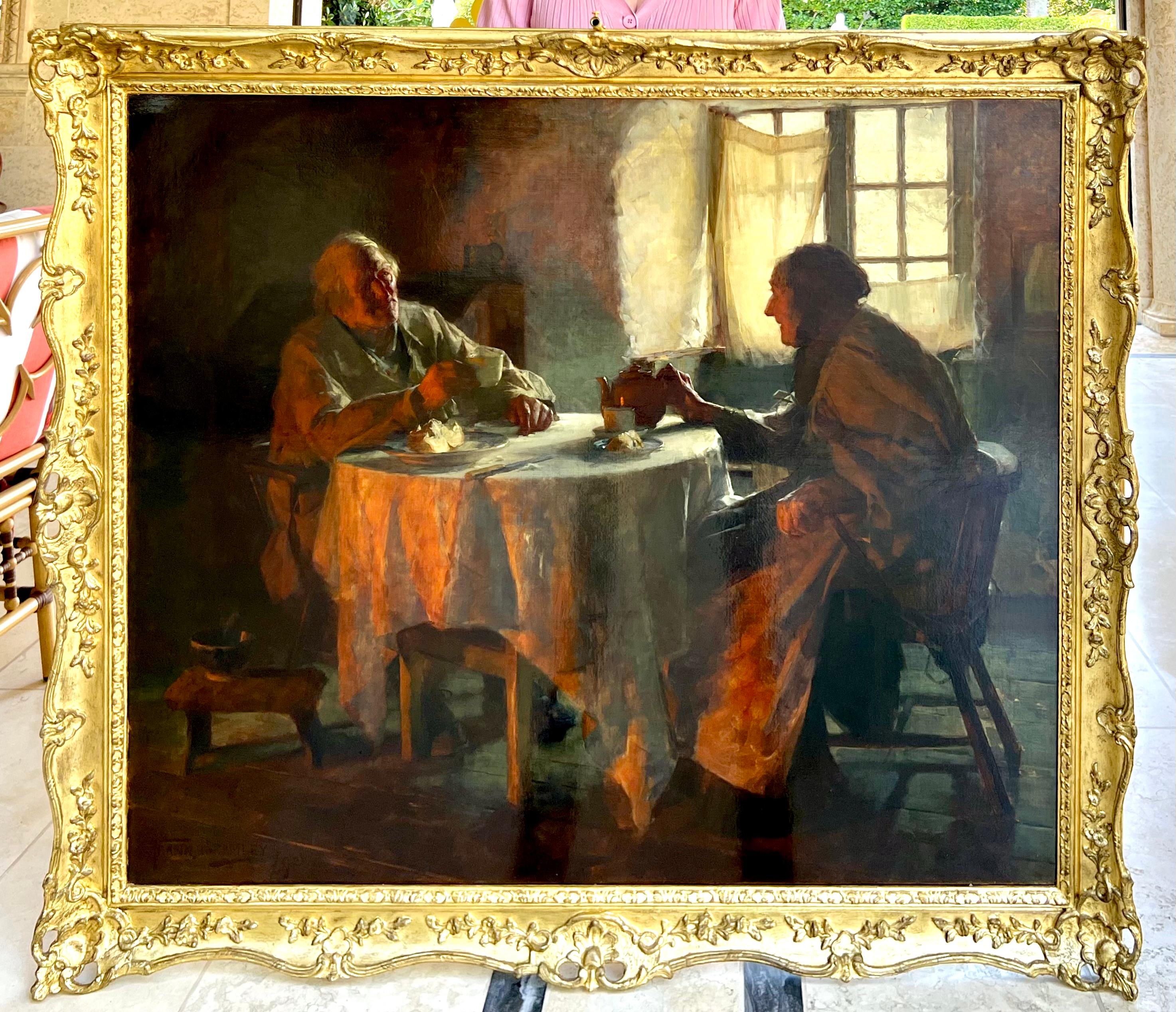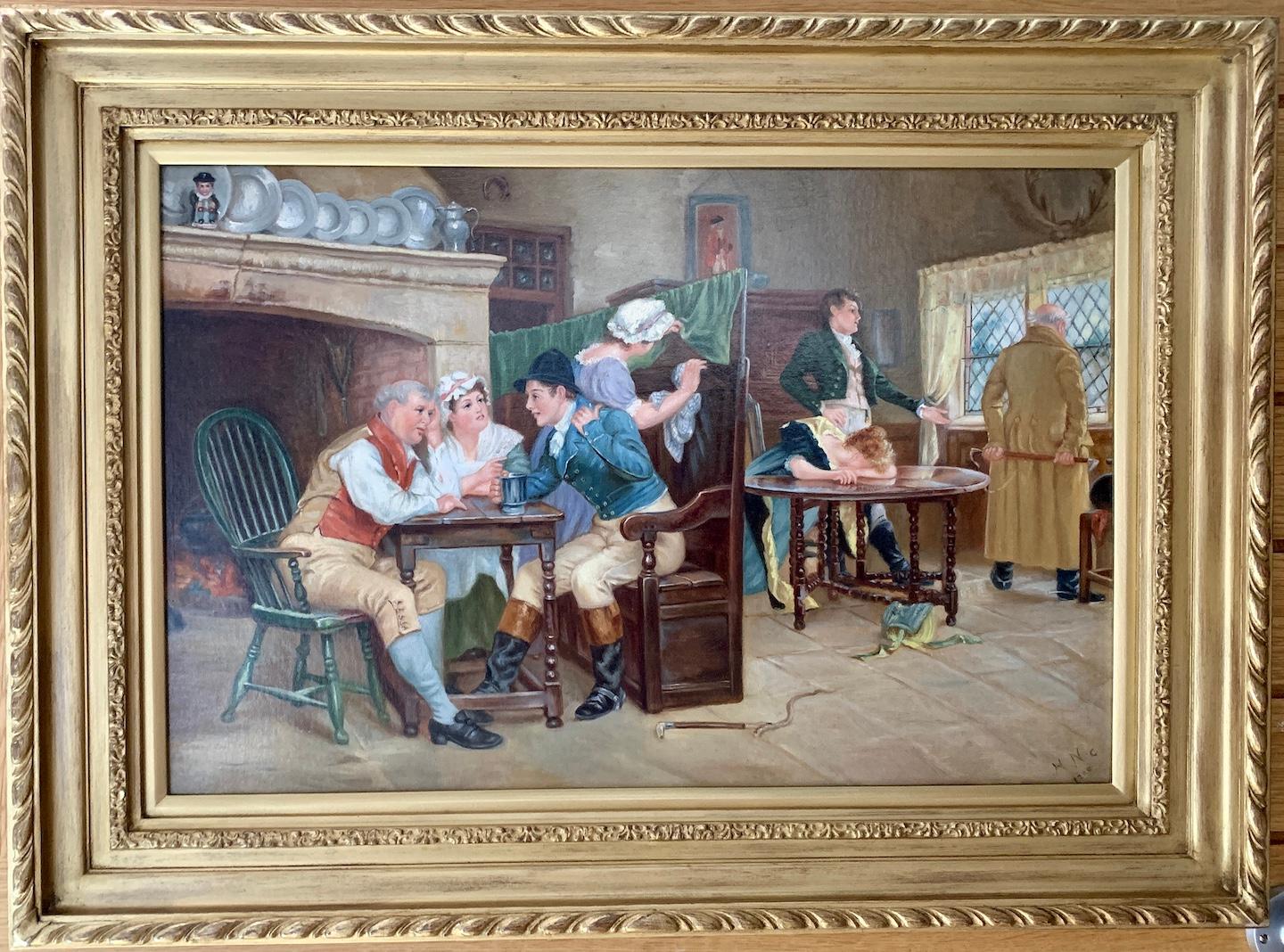Edward Antoon PortieljeOn the Look Out1910
1910
About the Item
- Creator:Edward Antoon Portielje (1861 - 1949, Belgian)
- Creation Year:1910
- Dimensions:Height: 23 in (58.42 cm)Width: 20 in (50.8 cm)
- Medium:
- Movement & Style:
- Period:
- Condition:
- Gallery Location:Nutfield, GB
- Reference Number:
Edward Antoon Portielje
Edward Antoon Portielje, the son of the Dutch artist Jan Frederik Pieter Portielje, primarily a portrait painter, was born on February 8th, 1861, in Antwerp. Edward’s brother, Geerard Jozef, was also an artist in the family tradition. He undertook artistic training at École des Beaux-Arts in Antwerp, studying under Charles Verlat, who also taught Van Gogh during the early 1880s. Portielje’s contributions to Belgian painting earned him the respected honor of knighthood from the state. He died on December 18th, 1949 in Antwerp. Portielje’s intimate interior scenes, in the artistic lineage of Belgian painter Jean-Baptiste Madou and the most recognizable of Portielje’s image for modern-day audiences, offer light-hearted reflections of leisure time rendered in warm tones that give his images such immensely appealing qualities. His reliance on local exhibitions shows his patriotism to the creation and advancement of typically Belgian art, in both theme and mood.
- ShippingRetrieving quote...Ships From: Naples, FL
- Return PolicyA return for this item may be initiated within 7 days of delivery.
- "Family Interior Scene”, peasant family in 19thC Austria, original oil on paperLocated in Nutfield, SurreyFrans Wens (19th Century). A charming family interior scene painted by the Austrian artist Frans Wens. There is little recorded biographical informat...Category
19th Century Victorian Interior Paintings
MaterialsPaper, Oil
- "The Beautiful Story”, period Belgian interior, romantic portraiture, oil/canvasBy Edward Antoon PortieljeLocated in Nutfield, SurreyThis is an original unique oil painting by the artist, Edward Antoon Portielje, a late nineteenth-, early twentieth-century Belgian painter from Antwerp, who showed an interest in se...Category
19th Century Romantic Portrait Paintings
MaterialsOil, Canvas
- Portrait of a young Swedish woman, bathed in warm firelight, Oil on PanelBy Sam UhrdinLocated in Nutfield, SurreySam Uhrdin (Swedish School, 1886-1964) Sam Uhrdin was born in 1886 in the Swedish town of Siljasnas to the north-west of St...Category
Early 20th Century Impressionist Portrait Paintings
MaterialsOil
- Two young women conversing in the kitchen, original oil on canvas, circa 1920By Edward Antoon PortieljeLocated in Nutfield, SurreyThis beautiful oil on canvas painting of two women conversing in the kitchen is circa 1920 and is by the artist Edward Antoon Portielje (1861, Antwerp - 1949) who was a Belgian genre painter. He was born to the painter, Jan Portielje...Category
1920s Flemish School Figurative Paintings
MaterialsOil, Canvas
- "Making Tea”, interior kitchen scene of a Swedish woman, original oil on canvasBy Sam UhrdinLocated in Nutfield, SurreySam Uhrdin (Swedish School, 1886-1964) Sam Uhrdin was born in 1886 in the Swedish town of Siljasnas to the north-west of...Category
20th Century 85 New Wave Portrait Paintings
MaterialsOil, Canvas
- "Mother and Daughters”, Dutch Interior scene, Romantic style, oil on canvasBy Bernard PothastLocated in Nutfield, SurreyBernard Pothast (1882-1966) Although born in Belgium in 1882, Bernard Pothast was the...Category
20th Century Romantic Portrait Paintings
MaterialsOil, Canvas
- Antique French 19th century Still life of flowers in a basketLocated in Woodbury, CTLucienne Lemercier was a French painter from the latter part of the 19th century through the early 20th century. She came from a family of creative people and took to painting at a...Category
1880s Victorian Still-life Paintings
MaterialsCanvas, Oil
- Tea TimeBy Frank BramleyLocated in Wiscasett, MESigned and dated 92 lower left. Oil on canvas. Frank Bramley British, 1857-1915 Frank Bramley is considered one of the most important artists of the Newlyn School, the group of artists who settled in Newlyn, Cornwall during the 1880s and 1890s, drawn by the light, lifestyle and the example of Alexander Stanhope Forbes, and were at the forefront of 'British Impressionism'. He was particularly ‘in the news’ when his painting of a woman reading in a garden made the astonishing price of $590,000 at Sotheby's New York in late May 1996. As the seminal catalogue of the famous Newlyn School exhibition states, Bramley's reputation has rested for some time on Hopeless Dawn, his major RA exhibition of 1888, and which in recent years has been hung almost constantly at the Tate Gallery. Bramley was born in Lincolnshire and trained at Lincoln Art School, later at Verlat's Academy in Antwerp, from where he went to Venice in 1882-83, where our painting was executed. He first showed at the Royal Academy in London in 1884 (both paintings were Venetian scenes), and it was in the winter of 1884/5 that Bramley settled in Newlyn. He was a quiet and reserved figure, prone to bouts of melancholy. He worked on his own in a tiny studio in an old thatched cottage - the cottage consisted of two rooms, one at ground level (which was the studio) and one which was below ground which was inhabited by a woman who'd lost her arms and who managed to look after a set of tiny children as well as a small potato and turnip shop. Bramley moved to a purpose-built glass studio in 1889. He is known as the master of the so-called 'square-brush technique' which characterizes much of the best Newlyn School work and he used this until 1893, later than most of his colleagues. Bramley was friendly with the great artist Sargent and with him was elected an associate of the Royal Academy in 1894, being elected a full member in 1911. In 1891 he had married, and 4 years later they moved to the Midlands where his work became less socially orientated and more purely decorative. His last years were spent in a London flat...Category
1890s Victorian Figurative Paintings
MaterialsOil
- Antique English 19th century interior with mother and child and family treasuresBy Daniel PasmoreLocated in Woodbury, CTDaniel Pasmore the Younger was a London genre and portrait artist who exhibited mostly at the Society of British Artists in Suffolk Street, London. He i...Category
1850s Victorian Interior Paintings
MaterialsCanvas, Oil
- Interior of Knole House, 19th Century Oil on Canvas PaintingLocated in London, GBThis grand scene depicts the interior of Knole House, a country house and former archbishops palace. Situated within the 1,000 acre Knole Park the house ranks in the top five of Engl...Category
Late 19th Century Victorian Interior Paintings
MaterialsCanvas, Oil
- !9th century English Pub interior , with Huntsmen and figures drinkingLocated in Woodbury, CTAttributed to Randolph Caldecott, a well-known English painter, and illustrator of English Pub interior scenes. The scene is great fun, as we can see di...Category
1890s Victorian Figurative Paintings
MaterialsCanvas, Oil
- Victorian Interior with Several Figures Antique English Oil PaintingBy Victorian SchoolLocated in Cirencester, GloucestershireThe Victorian Interior English School, 19th century oil on board, framed behind glass hence photo reflection glare framed: 7 x 8.5 inches board: 4 x 5 inches inscribed verso provenan...Category
19th Century Victorian Figurative Paintings
MaterialsOil





